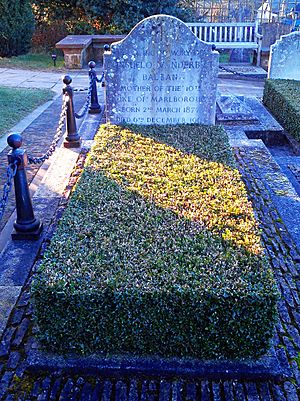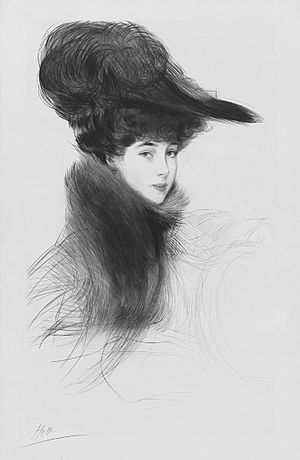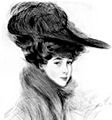Consuelo Vanderbilt facts for kids
Quick facts for kids
Consuelo Vanderbilt
|
|
|---|---|

c.1900–05
|
|
| Born | 2 March 1877 Manhattan, New York City, U.S. |
| Died | 6 December 1964 (aged 87) Southampton, New York, U.S. |
| Resting place | St Martin's Church, Bladon, Oxfordshire, England |
| Spouse(s) |
Charles Spencer-Churchill, 9th Duke of Marlborough
(m. 1895; div. 1921)Jacques Balsan
(m. 1921; died 1956) |
| Issue |
|
| Parents |
|
Consuelo Vanderbilt-Balsan (born Consuelo Vanderbilt; March 2, 1877 – December 6, 1964) was a famous American socialite. She was part of the very wealthy Vanderbilt family.
Her first marriage to the 9th Duke of Marlborough is a well-known example of arranged marriages from the Gilded Age. This was a time when rich American families often married their children to European nobles. The Duke gained a lot of money from the marriage, and Consuelo became a popular duchess.
Even though she was forced into this marriage, Consuelo used her position to help others. She later married a French aviator named Jacques Balsan. She continued her important charity work throughout her life.
Contents
Who Was Consuelo Vanderbilt?
Her Early Life
Consuelo Vanderbilt was born in New York City. She was the only daughter of William Kissam Vanderbilt, a very rich railroad owner. Her mother was Alva Erskine Smith, who later became a supporter of women's rights.
Consuelo was named after her godmother, Consuelo Yznaga, who was also a well-known socialite. A socialite is someone who is famous for attending many social events.
Consuelo's mother, Alva, was very strict. She wanted her daughter to marry someone important and wealthy. Consuelo even had to wear a steel rod to improve her posture. She was taught at home by tutors and learned several languages. Her mother once told her, "I do the thinking, you do as you are told."
Many noblemen wanted to marry Consuelo because of her family's wealth. Her mother received many marriage proposals for her. Consuelo was known for her beauty. One writer, J. M. Barrie, even said he would stand all day just to see her.
Her First Marriage
Consuelo's mother arranged a meeting between Consuelo and Charles Spencer-Churchill, 9th Duke of Marlborough. He was a British duke who needed money to save his family's grand home, Blenheim Palace.
Consuelo did not want to marry the duke. She was secretly engaged to an American man named Winthrop Rutherfurd. Her mother tried everything to make her agree. When Consuelo planned to run away, her mother locked her in her room.
Her mother even pretended to be very sick to get Consuelo to agree. Consuelo finally gave in. She reportedly cried during the wedding. The duke received a large sum of money from the marriage. Consuelo's father also built her a mansion in London.
Consuelo Vanderbilt married the 9th Duke of Marlborough on November 6, 1895, in New York City. They had two sons: John Albert William Spencer-Churchill and Lord Ivor Spencer-Churchill.
Life as a Duchess
As the Duchess, Consuelo was loved by the people living on her husband's estate. She visited them and offered help. She also became involved in many charity projects. She cared especially about helping mothers and children.
She was also popular with the royal family and nobles in Britain. However, her marriage to the duke was not happy. They lived separately for much of their marriage. The duke later became interested in another woman.
The Marlboroughs separated in 1906 and divorced in 1921. Their marriage was later officially canceled in 1926. This was done so the duke could convert to Roman Catholicism. Consuelo's mother even said that she had forced her daughter to marry the duke.
Her Second Marriage and Later Years

Consuelo married for a second time on July 4, 1921. Her new husband was Lt. Col. Jacques Balsan. He was a French pilot who had set many records in balloons, airplanes, and hydroplanes. He even worked with the famous Wright brothers. Jacques Balsan passed away in 1956.
Even after her first marriage ended, Consuelo remained close with some of her former husband's family. She was especially good friends with Winston Churchill. He often visited her home in France in the 1920s and 1930s.
In 1932, Consuelo built a home in Florida, USA. It was a large house called Casa Alva, named after her mother.
Consuelo Balsan wrote her autobiography, The Glitter and the Gold, in 1953. It told her life story. She passed away on December 6, 1964, in New York. She was buried in England, near Blenheim Palace, her former home.
Helping Others: Public Service
During World War I, Consuelo Vanderbilt led a committee that provided economic help. This was part of the American Women's War Relief Fund.
Between the two World Wars, she worked with another wealthy woman, Winaretta Singer-Polignac. They helped build a large hospital in France with 360 beds. This hospital was meant to provide medical care for middle-class workers.
This effort resulted in the Foch Hospital in Suresnes, a suburb of Paris, France. The hospital also has a nursing school. It is still one of the top hospitals in France today. It continues to serve the community as a private, non-profit institution.
Gallery
Images of Vanderbilt by artist Paul César Helleu:
See also
 In Spanish: Consuelo Vanderbilt para niños
In Spanish: Consuelo Vanderbilt para niños









